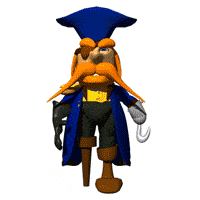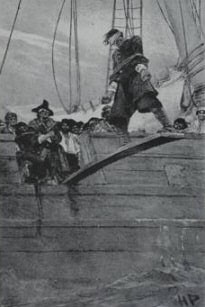
Pirates believed wearing ‘pierced’ earrings would improve their eyesight – strange Will and Guy think.
Seven Funny Pirate Jokes
- Why can’t you play cards on a pirate ship? The captain keeps standing on the deck.
- How do you make a tall pirate short? You take all his money.
- What does the ocean say when it sees the shore? Nothing, it just waves.
- What happened to the man with two wooden legs when his trousers caught fire? He was burnt to the ground.
- What does a pirate’s parrot eat? Polyfiller.
- Which pirate wears the biggest hat? The one with the biggest head.
- Question: Who’s that at the door?Answer: A pirate with a wooden leg. Questioner: Tell him to hop on it.
Walking the Plank

Hollywood, Robert Louis Stevenson’s ‘Treasure Island’ and the story of Peter Pan, are responsible for perpetuating the myth that pirates used to kill their enemies by making them ‘walk the plank.’
The fact, it is hard to imagine that real pirates such as Captain Kidd would waste time killing someone by drowning in this fashion. A quick throw overboard would suffice. If a buccaneer wished to be cruel or wanted to torture their victim, then Keel-hauling would be more effective.
Another reason why ‘Walking the Plank’ is lionized is because of Howard Pyle’s illustrations in the 19th Century. The picture first appeared in Harper’s Monthly in 1887.
Pirate Trivia and Interesting Facts

- The Jolly Roger flag, with its black background and white skull and crossbones, was designed to be scary. This flag was not used by all pirates, usually, it was only flown by those sailing in the Spanish Main.
- Pirates believed that wearing ‘pierced’ earrings would improve their eyesight – strange we think.
- Pirates believed that having women on board their ships was bad luck.
- They also believed that whistling on a ship would cause the weather to turn stormy; as in the phrase ‘to whistle up a storm’.
- Pirates would take over island ports and make them a safe haven for pirates.
- Almost all pirates stole their ships because they couldn’t buy ships in case they got caught and sent to jail. Once they had taken over a ship they had to convert it for pirate life, this usually meant making more room for sailors to live on board and strengthening the decks to hold the weight of the heavy cannons.
- Ships sailing on their own often sailed close to warships or joined other convoys of ships to protect themselves from pirates. Pirates could only attack one ship at a time, so if the sailors traveled in groups there was less chance of their boat being the one that was attacked.
- Pirate captains would change out of their expensive, flashy clothes if there was a chance they might be captured. This way they could pretend they were only one of the crew, and not somebody important and hopefully escape.
- Pirates probably didn’t have talking parrots say Will and Guy.
- Although pirates have been around since the 15th century, most pirating happened between 1690 and 1720.
- On the Caribbean island of St Thomas, you will find a place called “Black Beard’s Castle”. It is believed that this is where the famous pirate spent many hours looking out for approaching ships.
Stories of Famous Pirates
Captain Morgan, typifies the buccaneer spirit. He also typified how both the establishment and history blurred the line between good and bad. If you were English and you robbed ships belonging to enemy countries such as Spain, then you were a good privateer. But if you looted English or allied ships, then you were a bad pirate. In 1673 Captain Morgan stood trial for piracy, however instead of being convicted, the King (Charles II) intervened personally, knighted Captain Morgan, and then made him governor of Jamaica.
Captain Kidd, the scourge of the Indian Ocean. Famously, Captain Kidd was hanged in London in 1701; his body was then dipped in tar, and displayed on the bank of the River Thames as a deterrent to would-be pirates.
Blackbeard terrorized the American coasts in the early 18th century. Killed in 1718 by Lieutenant Maynard of the Royal Navy (Pre-independence).
Fascinating Pirate Facts from Will and Guy
Did You Know There Are Four Different Types of Pirate:
1) Buccaneers Buccaneers were rovers who plied their sweet trade in the Caribbean. The original name is Boucanier; meaning someone who barbecues meat. The original buccaneers were hard, strong men who were involved in the wood trade. When economic times were tough, they resorted to piracy to make ends meet.
2) Corsairs Corsairs was the name given to pirates who plied their sweet trade off the coast of North Africa. The Barbary Corsairs were a band of pirates who sailed off the Barbary Coast.
The Barbary states were semi-autonomous Muslim cities along the coast from which the pirates hailed. Their chief claim to fame is the cruel manner in which they treated Christian captives, who were chained to the benches of Corsair galleys and made to row nonstop for hours on end. If the rower quit, he was mercilessly whipped to death and tossed to the waves.
Corsair forts were known to be places where prisoners were maltreated in a great variety of ways; including being tossed onto hooks which were imbedded in the outer wall of the fort’s gate and left to rot in the hot sun.
3) Pirates Pirates are people who rob and plunder at sea; the sea-worthy equivalent of highwaymen. Down the centuries Kings and Queens have done both through their surrogates; privateers and tax collectors.
4) Privateers Privateers were often private boat owners who operated under a ‘Letter of Marque’ from their government, which allowed them to plunder the ships of “enemy” countries.
Privateers also used their vessels to help protect their country in the event of war. As Samuel Johnson’s dictionary definitions make clear, in the eighteenth century ‘the difference between a pirate and a privateer was as thin as the piece of paper bearing a royal letter of marque.’
Rare Jolly Roger Goes on Display at Portsmouth’s Navy Museum
The red color signifies that no life would be spared in a battle. Will and Guy can reveal that in Will’s hometown of Portsmouth, England an extremely rare 18th Century red “Jolly Roger” pirate flag has gone on display at Portsmouth’s navy museum.
The flag was captured in battle off the North African coast in 1780 by one Lieutenant Richard Curry, Royal Navy, who later became an admiral.
Pirates used skull and crossbones flags to frighten passing ships into surrendering without a fight. The flag is on show at the National Museum of the Royal Navy (NMRN) at Portsmouth Historic Dockyard. The red background – rather than black – signified the pirates intended to spare no life if a battle broke out during a ship’s capture.
When it was restored at the Winchester School of Art’s Textile Conservation Centre in 2007, gunpowder and small holes with charred edges were found on the flag. The Jolly Roger has been loaned to the museum by its current owner Pamela Curry, a descendant of Lt Curry.
The Jolly Roger is the most famous pirate flag. The skull and crossbones came from the symbol used in ships’ logs, where it represented death on board. It was first used as a pirate flag around 1700 and quickly became popular.
As piracy developed, more flags were used, and pirates often had their own versions, such as a skull and crossed swords. The title Jolly Roger is thought to come from the French phrase “joli rouge” which means “pretty red” explains Will.
Pirate Vocabulary
Will and Guy have researched some vocabulary that you may enjoy using in your conversations:
- Growl – and scowl often. Pirates don’t use a cultured, elegant, smooth vocalization – they mutter and growl.
- Ahoy: Greetings, also Hallo, Hi there.
- Avast: Stand still and listen.
- Aye or Aye Aye: Yes. OK.
- Aaaaargh: can mean anything you want it to.
- Black spot: by giving someone a black spot [place it in their hand] you are marking them for death or misfortune.
- Booty: treasure searched for by pirates
- Cat o’ nine tails: special whip for flogging wrongdoers and those that mutiny.
- Davy Jones’ Locker: the bottom of the sea, where the souls of dead men lie.
- Doubloons: gold coins.
- Gentlemen O’ Fortune: posh word for a pirate.
- Grog: A pirate’s favourite drink – rum usually because of the Caribbean connection.
- Jolly Roger: the skull and crossbones, the pirate flag.
- Keelhaul: a truly vicious punishment where a malcontent or wrongdoer was tied to a rope and dragged along the barnacle-encrusted bottom of a ship. He would not survive this experience.
- Landlubber: ‘land-lover,’ someone not used to living onboard a ship.
- Lily-livered: faint-hearted.
- Loaded to the gunwales (pronounced gunnels): probably means to be inebriated.
- Matey: a shipmate or a friend. Also useful is Me hearty.
- Pieces of eight: pieces of silver which could be cut into eighths thus enabling change to be given.
- Privateer: a private warship owned by a pirate and officially sanctioned by a national power. e.g. Sir Francis Drake.
- Scurvy dog: a personal insult.
- Shiver me timbers: an exclamation of surprise.
- Swashbuckling: fighting and having fun on the high seas.
- Walk the plank: exactly what it says on the tin……………..
- Wench: a young pretty lady.
- Yo-ho-ho: the way a pirate laughs, often heard with, ‘………………….and a bottle of rum.’
Council Apologises to Tattershall Boy over Pirate Flag
A seven-year-old boy who was told to take down his pirate flag by a Lincolnshire council has received a letter of apology. The young lad, who has Asperger’s syndrome, was told his Jolly Roger breached planning regulations.
East Lindsey District Council said it had acted after a complaint was made about the flag. However, it has now sent the family an official apology saying no further action would be taken.
In a letter, the authority said it wanted to ‘take the opportunity to apologize to you formally for the severity of the letter you received in relation to the pirate flag you were flying in the garden for your son, Anthony. When we receive a planning-related complaint, the council has a duty to write to make those concerned aware, but accept on this occasion our letter was over the top.’
A good thing too, say Will and Guy.
Gruesome Pirate Story
Jackson saw an old seafaring friend walking along the seafront at Southsea. ‘Hello Harry,’ he said, ‘How are you?’
It was only then that Jackson realized that Harry only had one leg!
‘What happened to you?’ he inquired. ‘My wife left me so I jumped in front of a train but it only took my leg off.’
Jackson then noticed that Harry only had one hand and in its place was a hook. ‘What happened to your hand?’ he asked.
‘I tried it again, ‘he replied,’ and the train just took my hand off.’
Jackson, again noticed that Harry also had a glass eye. ‘What’s up with your eye?’ he asked, this time with considerable trepidation.
‘Well,’ said Harry, ‘after two attempts to take my life I thought God doesn’t want me to die, so I looked to the sky and said ‘thank you, God’, and a passing seagull made a deposit right in my eye ! !!
‘But you can’t lose an eye through bird muck.’ insisted Jackson.
Harry looked down at the floor and said, ‘I’d only had the hook for three days!’






